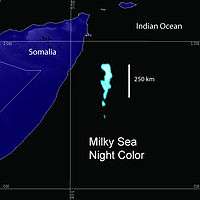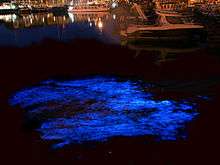Milky seas effect

Milky seas, or mareel, is a condition on the ocean where large areas of seawater (up to 6,000 sq mi or 16,000 km2) appear to glow brilliantly enough at night to be seen by satellites orbiting Earth. Modern science only tentatively attributes this effect to bioluminescent bacteria or dinoflagellates, causing the ocean to uniformly glow an eerie blue at night. However, there is no modern research to prove that bioluminescent bacteria are capable of illuminating the ocean from horizon to horizon and for days at a time, as described in mariner's tales for centuries (notably appearing in chapter 23 of Jules Verne's Twenty Thousand Leagues Under the Sea); and, in fact, the effect has not been rigorously documented nor thoroughly explained, even in modern times.
Effect

There have been 235 documented sightings of milky seas since 1915[1] - mostly concentrated in the north-western Indian Ocean and near Indonesia.[2]
In 1985 a research vessel in the Arabian Sea took water samples during milky seas. Their conclusions were that the effect was caused by the bacteria Vibrio harveyi. Mareel is typically caused by Noctiluca scintillans (popularly known as "sea sparkle"), a dinoflagellate that glows when disturbed and is found in oceans throughout much of the world.[3][4][5] In 2015,July in Alleppey, Kerala, India the Phenomenon occurred and the National Institute of Oceanography and Kerala Fisheries Department researched and found that the Glittering Waves were the Result of the Noctiluca scintillans. In 2005, Steven Miller of the Naval Research Laboratory in Monterey, California, was able to match 1995 satellite images with a first-hand account of a merchant ship. U.S. Defense Meteorological Satellite Program showed the milky area to be approximately 15,400 km2 (5,900 sq mi) (roughly the size of Connecticut). The luminescent field was observed to glow over three consecutive nights.
While monochromatic photos make this effect appear white, Monterey Bay Aquarium Research Institute scientist Steve Haddock (an author of a milky seas effect study) has commented, "the light produced by the bacteria is actually blue, not white. It is white in the graphic because of the monochromatic sensor we used, and it can appear white to the eye because the rods in our eye (used for night vision) don't discriminate color."[6] In Shetland (where generally caused by Noctiluca scintillans), mareel has sometimes been described as being green,[7] rather than the traditional blue or white milky seas effect seen by the rest of the world. It is not known whether this difference depends on the area, or simply a perception of a cyanic colour as being green.
Etymology
The phenomenon is known as mareel in Shetland. This term is derived from the Norn word *mareld, which is itself derived from the Old Norse word mǫrueldr, which is a compound of marr (mere, sea) and eldr (fire). [lower-alpha 1]
Notes
- ↑ Cognates of mareel include the Icelandish term maurildi which refers to both the mareel itself, and also to the Noctilucales order of marine dinoflagellates that bring about the mareel, Danish morild, Norwegian morild or moreld, Swedish mareld, and Finnish merituli.
References
- ↑ https://books.google.com/books?id=ty8eAQAAIAAJ&q=%22235+reports+ascribable+to+milky+seas%22&dq=%22235+reports+ascribable+to+milky+seas%22&hl=en&sa=X&ei=ZQv2VL7ZDYe8ggTrjYGYAw&ved=0CB4Q6AEwAA
- ↑ https://www.ncbi.nlm.nih.gov/pmc/articles/PMC1242338/
- ↑ Tada; Pithakpol; and Montami (2004). Seasonal variation in the abundance of Noctiluca scintillans in the Seto Inland Sea, Japan. Plankton Biol. Ecol. 51(1): 7-14.
- ↑ Buskey (1994). Growth and bioluminescence of Noctiluca scintillans on varying algal diets. Journal of Plankton Research 17(1): 29-40.
- ↑ Oceana: Noctiluca scintillans. Marine Animal Encyclopedia. Retrieved 27 December 2014.
- ↑ David Pescovitz at 9:51 am Tue, Oct 4, 2005 (2005-10-04). "First milky sea photo". Boing Boing. Retrieved 2014-07-17.
- ↑ Moncrieff, Helen. "Mareel - Lights From The Sea". The RSPB Community. Retrieved 2 July 2014.
Further reading
- Detailed discussion and images of milky sea observation
- BBC News: 'Milky seas' detected from space
- Miller, S.D., S.H.D. Haddock, C.D. Elvidge, T.F. Lee. Detection of a bioluminescent milky sea from space. Proceedings of the National Academy of Sciences. v102:14181-14184 Abstract
- Nealson, K.H. and J.W. Hastings (2006) Quorum sensing on a global scale: massive numbers of bioluminescent bacteria make milky seas Appl. Environ. Microbiol. 72:2295-2297. Manuscript
- Milky Sea Account from a sailing yacht in the India Ocean 2006
